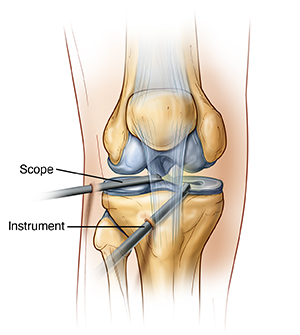Knee problems can often be diagnosed and treated with a technique called arthroscopy. This type of surgery is done using a tool called an arthroscope (scope). Only a few small incisions are needed for this surgery. The procedure can be used to diagnose a knee problem. In many cases, treatment can also be done using arthroscopy.
The arthroscope
The scope lets the healthcare provider look directly into the knee joint. It is about the size of a pencil and has a pathway for fluids. It also contains coated glass fibers that beam an intense, cool light into the knee joint. A camera is attached to the scope as well. It provides clear images of most areas in your knee joint. The provider sees these images on a screen.
Preparing for the procedure
-
Have lab or other testing done as advised.
-
Tell your healthcare provider about any medicines or supplements you take.
-
Follow all instructions your provider gives you for not eating or drinking before the procedure.
-
Once you arrive for surgery, you will be given an IV (intravenous) line in your arm or hand. This provides fluids and medicines.
-
To keep you pain-free during the surgery, you’ll receive medicine called anesthesia. You may have:
-
General anesthesia. This puts you into a deep sleep during the surgery.
-
Regional anesthesia. This numbs the body from the waist down. Or it numbs a larger part of the leg that is being operated on.
-
Local anesthesia. This numbs just the knee.
-
Along with regional or local anesthesia, you may receive sedation. This medicine makes you relaxed and sleepy during the surgery.
The procedure
-
A few small incisions (portals) are made in your knee.
-
The scope is inserted through a portal.
-
Sterile fluid is put into the knee joint. This makes it easier to see and work inside your joint.
-
Using the scope, the healthcare provider confirms the type and degree of knee damage. If possible, the problem is treated at this time. This is done using surgical tools put through the other incisions.
-
When the surgery is done, all tools are taken out. The incisions are closed with stitches, staples, surgical glue, or strips of surgical tape.
Risks and possible complications of arthroscopy
All surgeries have risks. The risks of arthroscopy include:
-
Bleeding
-
Infection
-
Blood clots
-
Swelling and stiffness of the knee
-
Injury to normal tissue
-
Continuing knee problems


